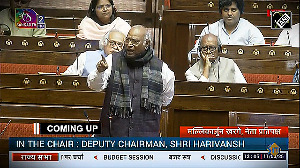His reforms, nee solution, is two-fold: first, reduce the RBI to an inflation-targeting institution because that is what "mature economies" do; and, second, allow the exchange rate to float freely, because that is the path of mature economies as well.
The recently released Raghuram Rajan Planning Commission report on financial reforms concurs with Ajay's recommendations and indeed its number one proposal is that "the RBI should formally have a single (inflation-targeting) objective".
Ajay has raised an important policy concern and his monetary policy recommendations need to be addressed by policymakers and economists. The first thing for all of us to realise is that all economists (and even the policymakers) have an ideology and a theology. (That obviously includes Ajay, Raghu and myself).
So how should policymakers decide on who to believe? The check and balance to economist recommendations is provided by empirical data. And consistent macro-economic data are available for over 150 countries and for a period of at least 50 years. That is more than 7,500 observations with which to test all theologies. I propose to test some of Ajay Shah's important policy conclusions with respect to data for both India and other countries.
Let us first examine the inflation-fighting abilities of exchange rate appreciation. Ajay Shah: "A 10 per cent rupee appreciation would yield a nice dent on inflation, as happened in March 2007." As we all remember, for reasons still unknown (at least to me and most policy wonks), the Indian rupee suddenly and unpredictably appreciated by 10 per cent between February and April 2007.
For these two months, annual y-o-y WPI inflation stayed constant at 6.3 per cent. No one contends, or no one should contend, that the lag between exchange rate change and its impact on inflation is either simultaneous or even a few months. What is true is that y-o-y inflation dropped to 3.1 per cent in Oct 2007. Today, just some five months later, the rate has touched 7 per cent. On a y-o-y basis, the 10 per cent exchange rate appreciation has actually resulted in an increase in inflation rate of around 1 per cent -- yeh to ulti ganga beh rahi hai.
Surely Ajay Shah's entire thesis of exchange rate appreciation affecting inflation rate is not based on a complete pass-through in a matter of a few months and a complete reversal just a few months later? There must be more to it? Unfortunately, it appears not. His recommendation is a policy for all seasons -- last year when imported inflation wasn't so high, and this year when it is. It did not work last year, and it will not work this year.
Empirical evidence is obtained for this conclusion from an analysis of exchange rate appreciation, and inflation, in more than a 100 countries of the world. A simple test is conducted -- does the change in inflation respond to currency change? These tests are conducted for various combination of countries, developed only, developing only, and so on.
Only countries with inflation rates above 20 per cent have been excluded. The result -- very, very, fragile support for the Ajay Shah hypothesis. When the coefficient for currency change is significant (less than a third of the time for the 47 years 1960 to 2007), the pass-through impact is very small. The coefficient is 0.05 for the recent post-2000 period, that is, a 10 per cent appreciation can reduce the inflation rate by only 0.5 percentage points. For just the Indian data, the coefficient is not significant.
Thus, there seems to be precious little evidence for the inflation-challenging properties of the exchange rate. What about the other pillar of Ajay Shah's recommendation: inflation-targeting. Tragically, the major central banks of the world (the mature countries in Ajay's terminology) adopted inflation-targeting only recently (over the last decade).
This period neatly coincided with a spurt in productivity growth in developing countries, especially India and China. This productivity growth has meant a decline in prices of many goods, and this has led to a decline in average rates of inflation. It is this decline that has now been trumpeted by scholars like Ajay as evidence of the wholesome nature of inflation targeting.
But many central banks have recognised the folly of a "mature inflation-targeting" approach. The most enlightened central bank, the US Federal Reserve, never had inflation targeting. The UK central bank is now likely to reduce rates because of slow growth rather than tighten monetary policy because of high inflation. Indeed, there isn't a "mature" central bank in the world today that is thinking of tightening monetary policy in response to higher imported goods inflation.
The lessons to be learnt from empirical evidence about growth, inflation, and exchange rate policy? If monetary (or fiscal) policy was as straightforward as Ajay makes it out to be, the Japanese would have invented a robot, or a cookie cutter, long time ago. So let us not be hasty in making simplistic recommendations, especially those not supported by empirical evidence.
In conclusion, I must mention that I am in complete agreement with Ajay in his recommendation of interest rate policy: a reduction in short-term interest rates for India. Again, my reason for agreement is because of strong empirical support for this proposition.
A reduction in interest rates will decrease capital inflows (because of reduction in interest rate arbitrage being indulged in by foreigners and foreign-based Indians, and by the investment banks who need easy riskless money to compensate for their sub-prime crimes), will decrease, ceteris paribus, the appreciation of the rupee, will help competitiveness, and allow Indian industry (and economy) to grow at potential.
The correct policy response to the current domestic and world situation is for the RBI to gradually put in place a regime that will bring domestic rates to be in line with world rates, that is, a large and significant reduction. If the RBI wants to lead the market, that is what it should do on April 29.
The author is Chairman, Oxus Investments, a New Delhi-based asset management company. The views expressed are personal. He can be reached at surjit.bhalla@oxusinvestments.com







 © 2025
© 2025